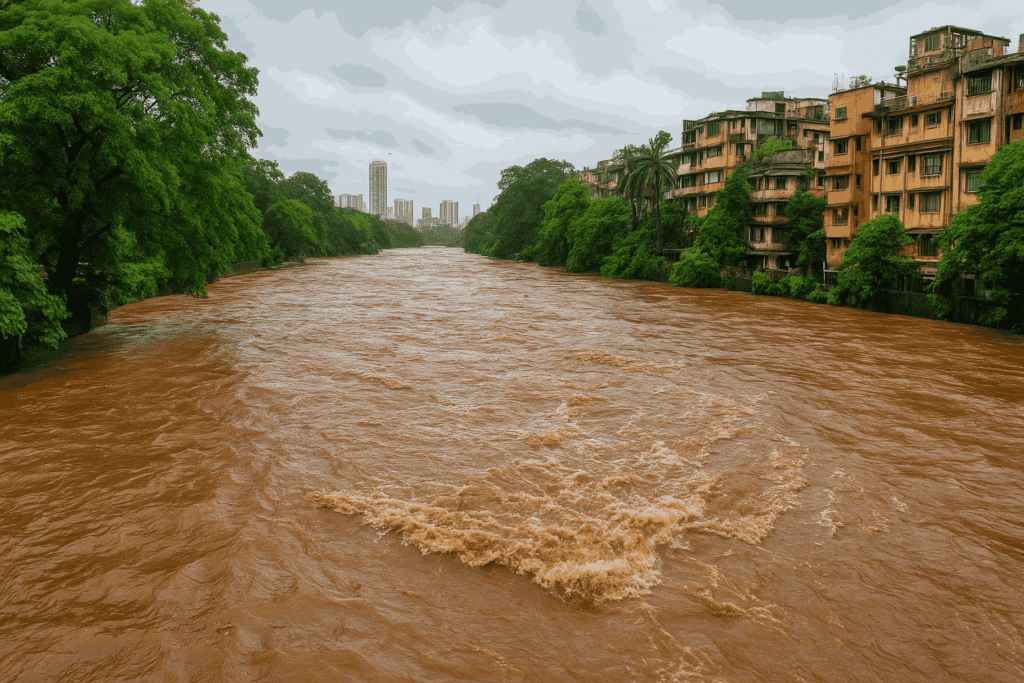Mumbai, India’s financial powerhouse, is once again gasping for breath under the weight of relentless monsoon fury. Recent days have seen the city plunged into chaos as extreme rainfall triggered widespread flooding, waterlogging, and the disruption of essential services like local trains .

At the heart of this recurring disaster lies a name that has become synonymous with the city’s vulnerability: the Mithi River. As the river swells, breaching danger levels and forcing hundreds to evacuate from low-lying areas like Kurla , the Mithi River is not just a geographical feature; it is a stark symbol of the complex interplay between climate change, inadequate urban planning, and environmental neglect.
The Immediate Crisis: When the Rain Doesn’t Stop
The immediate trigger for the current crisis is the sheer volume of rainfall. The India Meteorological Department (IMD) has been issuing a series of alerts, from yellow to red, warning citizens of intense downpours and the potential for flash floods . Recent reports indicate that parts of the city received staggering amounts of rain, with one area recording nearly 140 mm in a single day . This deluge, falling on an already saturated city, overwhelms the drainage system.
The Mithi River, which is designed to drain excess water from the city, instead becomes a conduit for disaster as it overflows its banks . The consequences are immediate and severe: neighborhoods are submerged, nearly 350 people had to be shifted to safer locations, and critical infrastructure grinds to a halt . Tragically, such events have also claimed lives, with reports of fatalities linked to the rains and flooding .
Read Also: Mumbai Under Extreme Rainfall Alert: How 2025’s Monsoon Is Putting the City to the Test
Beyond the Rain: The Deep-Rooted Problems of the Mithi River
While the extreme rainfall is the catalyst, the severity of the flooding points to deeper, systemic failures. The Mithi River is not merely a victim of the weather; it is a victim of decades of human intervention and neglect.
- A River Suffocated by Waste and Encroachment: The Mithi has been transformed from a vibrant waterway into a heavily polluted and clogged channel . It is burdened with solid waste, sewage, and industrial effluents, turning it into little more than an open sewer in many stretches . This pollution is not just an environmental catastrophe ; it directly hampers the river’s ability to carry water efficiently. Furthermore, rampant encroachment along its banks has drastically reduced its natural width and flow capacity, leaving no room for the river to expand during heavy rains .
- The Loss of Natural Defenses: The river’s ecosystem has been critically damaged. The once-extensive mangrove forests that acted as natural buffers, absorbing floodwaters and protecting the coastline, have been decimated . The loss of these vital green lungs has left the city more exposed to the impacts of flooding and storm surges.
- Climate Change: The Intensifying Factor: The frequency and intensity of extreme rainfall events in Mumbai are being amplified by climate change . Rising sea levels also threaten the city’s low-lying areas and can impede the natural outflow of rivers like the Mithi into the sea, exacerbating the flooding problem . This changing climate pattern means that the city must now prepare for rainfall events that were once considered rare but are becoming the new normal .
Read Also: Flood Situation Near Krishna River: Karnataka’s Monsoon Crisis Unfolds
The Path Forward: Restoration, Resilience, and Responsibility
The situation demands more than just reactive measures like issuing rainfall warnings. A comprehensive, long-term strategy is essential to transform the Mithi River from a liability into an asset.
- Comprehensive Restoration Projects: Several ambitious plans have been announced, including the Mithi River restoration project, which aims to widen the channel, dredge the riverbed, remove encroachments, and stop the discharge of sewage and effluents . The establishment of sewage treatment plants along the riverbank is a crucial step to address the pollution at its source . Initiatives like the “Mithi River Action Plan” envision a holistic approach, focusing on pollution reduction, habitat restoration, and community engagement to make the river a clean resource again .
- Building Urban Resilience: Mumbai must move beyond a purely flood-management perspective for the Mithi . This means investing in “nowcasting” technologies for better early warning systems , restoring other natural water bodies, and adopting sustainable urban design that incorporates green spaces and permeable surfaces to absorb rainwater . The city’s disaster management plans need to be robust, well-practiced, and inclusive, ensuring the safety of all citizens, especially those in vulnerable slum areas .
- A Collective Effort: The restoration of the Mithi River is not solely the government’s responsibility. It requires a collective effort involving citizens, private sectors, and urban planners . Community-led initiatives for cleanup and data-driven advocacy can play a vital role in holding authorities accountable and fostering a sense of ownership .
The story of the Mithi River is the story of Mumbai itself—resilient, yet strained to its limits by rapid growth and environmental pressures. Every monsoon season brings the same cycle of alerts, flooding, and recovery. Breaking this cycle requires acknowledging that saving the Mithi is not just about preventing floods; it is about securing the sustainable future of one of the world’s most dynamic megacities. The time for half-measures is over. The city must act decisively to restore its river, rebuild its resilience, and ensure that the next rainfall warning does not herald another disaster.

